Dream of returning to the prosperous Chang 'an, a wandering record belonging to Xi'an
The ancient capital of the thirteen dynasties is Chang 'an in the prosperous times.
If I had to use a city to represent China, I think I would choose Xi'an.
In the land of Xi'an, we have witnessed China's five thousand years of long history.
From Qin Shi Huang unified China to Emperor Wu of Han Dynasty who made great contributions here
From the prosperous Western Zhou Dynasty to the prosperous Tang Dynasty in Chang 'an
Xi'an has witnessed the rise and fall of one dynasty after another.
Now in Xi'an, thousands of homes are brightly lit and thousands of miles of pavilions send each other off.
After the last time I skipped class and came to Xi'an alone without telling my parents, seven years later, I came to Xi'an again.

When Chen Kaige's "The Legend of the Demon Cat" gives us a scene of the prosperous Tang Dynasty,
When "Chang 'an Twelve Hours" brings Chang' an's worldly fireworks to us,
I really love this magnificent scene.
Perhaps Xi'an is no longer what it was then, but every New Year, it will turn into a prosperous scene.
In the Chinese New Year, look at Xi'an. The place with the most New Year flavor in China must be in Xi'an.

Thousands of lights illuminate Xi'an
Chinese people have a custom during the New Year, which is to go out with their families to enjoy the lanterns at night. Therefore, various lantern festivals and temple fairs have also been born in various places.
The Lantern Festival in Xi'an can be said to be the brightest Lantern Festival I have ever seen. Various shapes of lanterns light up the night sky of the entire city. During the Chinese New Year, Xi'an, accompanied by the Lantern Festival, seems to be a city that never sleeps. After browsing Xi'an night scene videos countless times on the Internet, I became fascinated by Xi'an again.

Xi'an City Wall Lantern Festival
The first stop of the Xi'an Lantern Festival is of course the most famous Xi'an City Wall. This city wall, which has stood for five thousand years, has witnessed the rapid development of the city. This year is the Year of the Gengzi and the Year of the Rat. The New Year Lantern Festival at the Xi'an City Wall joins the Shanghai, Nanjing and Moscow Lantern Festival to light up the Year of China. The colorful lanterns seem to congratulate the people of the country on the New Year, and staged a new lantern feast in Vientiane during the New Year Festival.

This year is the Year of the Rat, so the mascots at the City Wall Lantern Festival are mainly mice. The two large mice in the center of the square are lively, and the star-shining golden mice look particularly dazzling under the city wall.
The Wengcheng Golden Rat, carved with the main lamp, shows the beautiful expectations of the Year of the Rat.
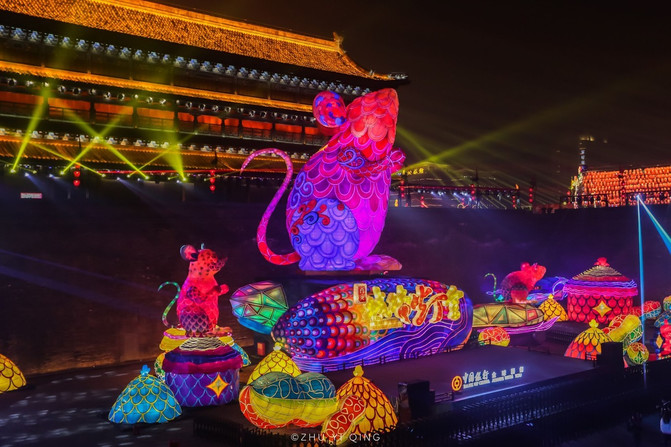
When I took a closer look, I found that there was a little mouse next to the golden mouse. It kept looking up in the direction of the golden mouse. When the big mouse and the little mouse looked at each other, they felt very cute.

There are five major sections in this city wall lantern festival, namely Shengshi Chang 'an, Happy Prayer Area, Splendid China Area, Dream Tongzhen Area, and Liuguang Ancient and Modern District. In the prayer area, various small Kongming lanterns bearing wishes for blessing warm people. Remember that it is very effective to come to this wall and make a wish.

Mouse lanterns can be seen everywhere at the lantern festival. The cute mouse-like shape makes the lantern in your hand play like a ball. The cute shape has won the likes of many girls. On the city wall, you can see people from all walks of life coming to enjoy the lanterns. Some are locals in Xi'an, and some are tourists who have come from afar to deliberately enjoy the lanterns.

This lantern is divided into four themes: Wengcheng Golden Rat, Twelve o'clock, Mushroom Kingdom and Shukbetta. When I saw the new three-dimensional image of Shukbetta also coming to celebrate the New Year, it seemed to evoke my childhood memories. It seems that the person who planned this lantern must also be a post-90s generation.

The various mushroom lanterns in the Mushroom Kingdom are like entering a fairy tale kingdom, where butterflies and bees dance.
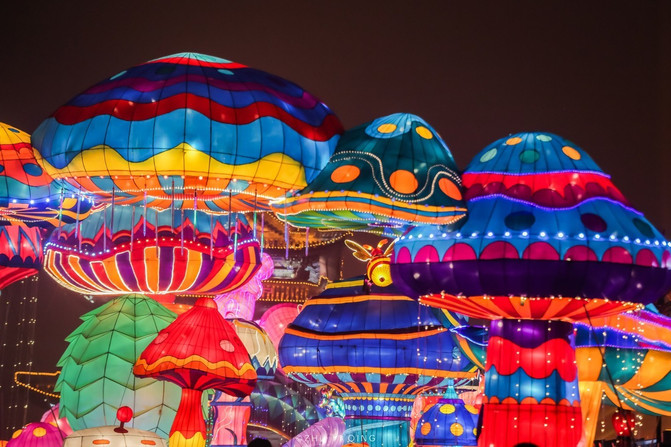
In fact, compared to simply admiring lanterns, I prefer the picture of these modern and lovely lanterns blending with the historical Xi'an Tower behind me. Think about the Tower five thousand years ago and the lanterns five thousand years later intertwined at this moment. How beautiful this picture is, and this scene may only be seen in Xi'an, an Internet popular city.

Every step we take, there are lanterns of different shapes waiting for us. These lanterns, stamped with historical marks, seem to let me see the Shangyuan Lantern Festival in Chang 'an, a thousand years ago. Perhaps it was as lively and bright as it is now.
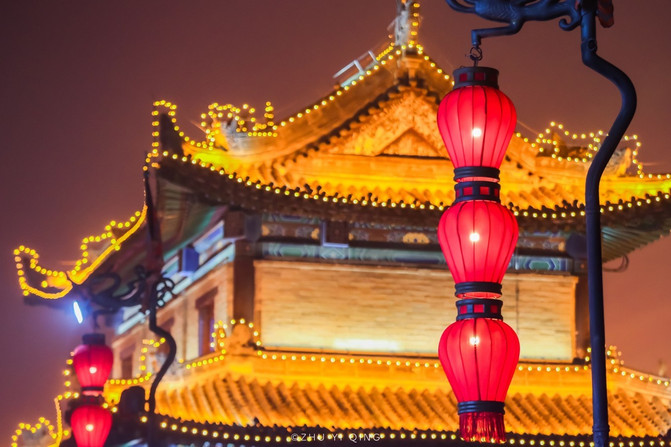
The lantern festival at the Xi'an City Wall refreshed my understanding of watching lantern festivals during the New Year. It turns out that lantern festivals can be so beautiful in shape, and it turns out that lantern festivals can also be so creative. Xi'an's Lantern Festival is not only at the Xi'an City Wall, but also among the major Internet celebrity attractions in Xi'an, there are unique lantern festivals waiting for tourists to arrive.

Huaqing Palace Tang Palace Lantern Festival
People in the Tang Dynasty liked to soak in hot springs, so they specially designed a hot spring pool, Huaqing Pool, for the emperor, which gradually evolved into a separate palace where the emperor traveled, Huaqing Palace. Huaqing Palace is backed by Mount Li and is known as China's four major royal gardens, along with the Summer Palace, Yuanmingyuan and Chengde Summer Resort. There is the beautiful love between Emperor Xuanzong of the Tang Dynasty and Imperial Consort Yang here, so the lantern festival held in Huaqing Palace is more romantic.

2020 also means loving you and loving you. The theme lantern festival of Huaqing Palace also carries the romance unique to the "Tang Dynasty". In this New Year, we can talk with the stars and dance with Lishan Mountain to witness the most beautiful moment of love. Huaqing Palace The various lanterns are also related to romance and love, in order to commemorate Emperor Xuanzong of the Tang Dynasty and Yang Guifei.
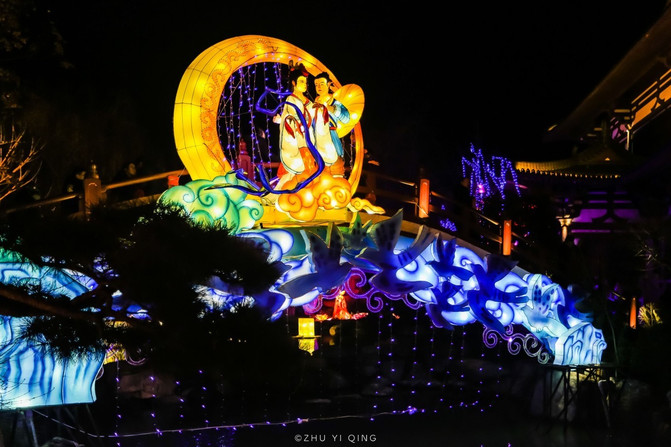
Similarly, the Lantern Festival in the Tang Dynasty Furong Garden also has several major themes. The first one is drone confession. Above Mount Li and under the Milky Way, hundreds of drones light up the night sky and transform into various shapes. The love we want to express will become the brightest star at night. Romance, starry sky, dream, everything is the most beautiful.

On the main stage of Huaqing Pool, actors dressed in Tang costumes danced their sleeves and had a flexible posture, interpreting the graceful dance posture of Chang 'an in the prosperous era of thousands of years ago. Their every move was full of charm. It is worth it to enjoy such dances at this lantern festival.

At the lantern festival, many children also joined in wearing red cotton-padded jackets. Their cute faces were beaming. Isn't the whole family together during the New Year?

The magnificent scene of the Tang Dynasty, where thousands of lights shine, more than 2000 stars shine, mountain moon screens, lake lake lights, pavilions and pavilions light effects, laser tunnel special effects, etc., creating a giant three-dimensional, landscape and prosperous scene in the prosperous Tang Dynasty. Just like Li Longji and Yang Yuhuan on this lotus leaf, in this prosperous age, they write an unprecedented love.

Suddenly looking back, the man was in the dim lights, holding hands with his beloved in this prosperous Tang Palace. Thousands of lanterns floated in front of your eyes, and the fire trees and silver flowers looked like a fairyland. They were grand, exquisite, or cute lanterns matched the New Year. They strongly brought your beloved TA and came to Huaqing Palace for a walk. Look, the romantic atmosphere lingered among the lovers in love.


Hold a lamp and watch a dance, be an ancient literary and artistic youth, enjoy lanterns, guess lantern riddles, set off fireworks, and dance dragons and lions. At the lantern festival, you can also experience the various customs and activities of the ancients when they admire lanterns, and travel back through the millennium., be an ancient person.


Although they are all lantern festivals, the lantern festival atmosphere of Huaqing Palace is still very different from that of Xi'an City Wall. If the city wall is the historical mark of Xi'an five years ago, then Huaqing Pool is the romantic love of the Tang Palace, and the lanterns on the city wall are childhood memories. The lantern festivals of Huaqing Palace are the memories of lovers. Every lantern is full of Huaqing Palace's affection for us.



Datang Furong Garden Lantern Festival
During the three nights in Xi'an, I changed places to watch the lantern festival every night. After watching the lantern festival at Xi'an City Wall and Huaqing Palace, the lantern festival at the Tang Dynasty Furong Garden was not to be missed. It is said to be the most beautiful lantern festival in Xi'an, which aroused my interest and I must go and have a look.

Tang Dynasty Furong Garden, China's first large-scale royal garden-style cultural theme park to fully display the style of the Tang Dynasty, was rebuilt north of the original Tang Dynasty Furong Garden site and modeled after the Tang Dynasty royal garden. There are many antique buildings such as Ziyun Tower, Ladies Hall, Royal Banquet Palace, Apricot Garden, Fanglin Garden, Fengming Jiutian Theater, Tangshi, etc. It is the largest imitation of Tang royal buildings in China.

The lantern festival in the Tang Dynasty Furong Garden is the longest lasting among the few lantern festivals. It lasts until March. As soon as you enter the Furong Garden, you will see all kinds of eye-catching lights blooming in the garden behind the Huang Family. In addition to the Qin Dynasty, the Tang Dynasty can best represent Xi'an, and the prosperity of the Tang Dynasty is the most vivid and vivid display of the beauty of Xi'an. Therefore, it is most appropriate to hold a lantern festival in a scenic spot dominated by the Tang Dynasty.

It is true that after watching the Lantern Festival in the Tang Dynasty Furong Garden, one can feel why it is called the most beautiful Lantern Festival in Xi'an. The huge lamp decoration floated on the water and reflected on the water. It was simply beautiful. Lights flow in the water, boats swim in the lights, and people walk in the lights. You can also choose to take a boat to enjoy the lanterns on the water and experience a different experience of viewing the lanterns.

Looking at the prosperity of the world and loving Chang 'an for the rest of your life, the New Year tide of the Tang Dynasty Furong Garden will recreate the prosperity of the royal market in the Tang New Year and restore the folk customs of the royal people in the Tang Dynasty and the New Year. There are a variety of Tang style folk customs activities in the park, restoring the folk activities and lifestyle during the Tang Spring Festival.


Hold a lantern and feel the mystery of Xi'an lanterns. On a cold night, with these lanterns accompanying me, I feel as enthusiastic as fire and feel warm. Shuttling through these lanterns makes people forget to leave.
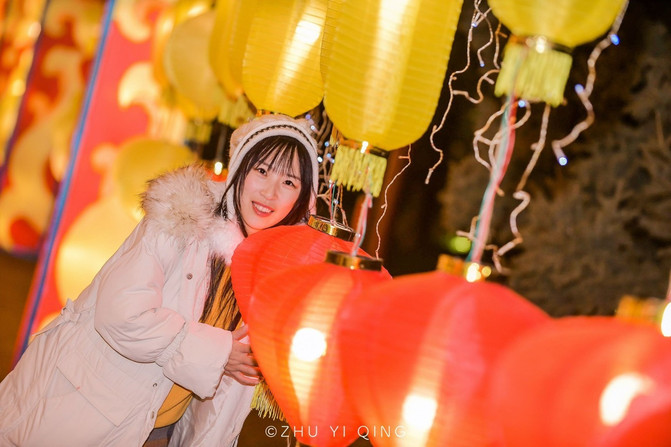


The Lantern Festival in the Tang Dynasty Furong Garden brings together New Year folk lanterns from many countries. The lights interact to render the Chinese Year, reproduce the scene of the Shangyuan Lantern Festival in the Tang Dynasty, and show the folk customs of various countries. Among them, the Chinese characteristics are the most obvious. The soaring dragon surrounds the long bridge, embellishing the long bridge vividly.

Visiting the Lantern Festival in Xi'an, at this moment, I felt like I had traveled back to the prosperous Chang' an. Accompanied by the lights of thousands of homes, I was immersed in this charming Chang 'an night.

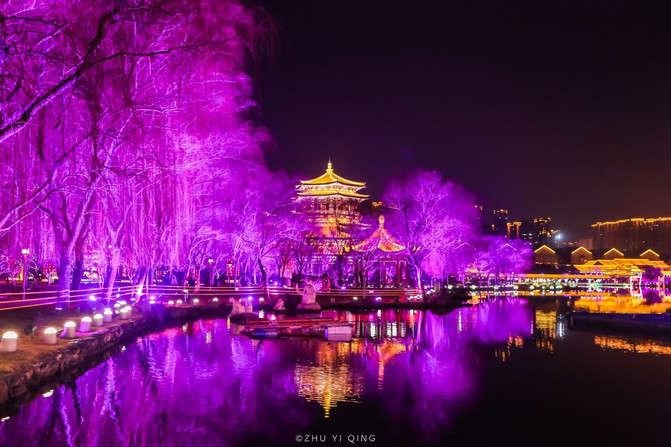
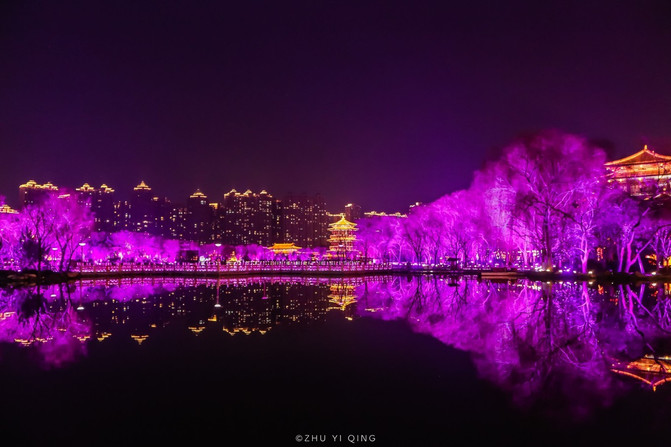
The mark of Xi'an, the lost years
Xi'an is like a living history book, full of strong historical traces everywhere. I once heard a story that it often takes a long time to build a subway in Xi'an, and cultural relics may be dug up. Moreover, sometimes we have to queue up when digging cultural relics. The Qing Dynasty has to wait for the Tang Dynasty, and the Tang Dynasty has to wait for the Qin and Han Dynasties. It is enough to see how much Chinese history is buried underground in Xi'an.

Banpo Site, Prehistoric Civilization
The history of Xi'an can be traced back to prehistoric civilization at the earliest, so according to the Timeline, my first stop was to the Cultural Relics Exhibition Unearthed at the Banpo Site to experience the birth of prehistoric civilization.

The Banpo Site is a settlement site of Yangshao Culture in the Neolithic Era. It is a village site left over from the prosperous period of the matriarchal clan in China's primitive society. It has a history of more than 6,000 - 6,700 years. Archaeologists have carried out five large-scale excavations on the Banpo site. Nearly 200 people have participated in the excavations, with a total excavation area of 10,000 square meters. Now this museum is built on the original site, which is also convenient for future generations to understand it.

The excavation of the Banpo site has promoted the research and development of Neolithic archaeology in China, revealing a large area of local features of the Banpo prehistoric settlement. Many prehistoric civilization utensils and other daily necessities are displayed in front of us, such as this point-bottom bottle, which opens my eyes. How to stand it on the table?

It can be seen that some of the ancient utensils are still in use today. Thousands of years ago, the wisdom of the ancients was really amazing.

The Banpo Site is a settlement site of the Yangshao Culture in the Neolithic Era. It is a matriarchal clan commune settlement. The houses excavated at the site have several shapes such as circular, square, and rectangle. In the center of the residence, there is a fairly large rectangular house with an area of about 160 square meters. It is a place for public activities for clan members.

A total of 45 houses, 2 enclosures, more than 200 cellar caves, 6 pottery kiln sites, and 250 tombs were excavated at the Banpo site, including 174 adult tombs and 73 children's urn coffins. The scene was restored one by one in the museum. About 10,000 pieces of unearthed production tools and daily necessities were also discovered, mainly including stone axes, stone adze, stone shovels, stone hoes, spearheads, arrows, harpoons, fish hooks, spinning wheels, bone needles, etc.

There is also an experience project at the Banpo Site, which is to experience how the ancients drilled wood to make fire. These are the tools used by the ancients to drill wood to make fire. They include stones, bows, ignited straw piles, and boards with small holes printed on them. Insert the wood in the air, tie the other end to the bow, borrow human power to pull the bow back and forth to rub the bow to generate heat. When there is spark, use the straw pile to ignite it, and then blow the fire to a bright spark.

The demonstration by the on-site staff was more intuitive. It turned out that the ancients 'drilling wood to make fire was not quite the same as our phenomenon. Only by seeing it with their own eyes can we know how to operate it.

Terracotta Warriors, a giant hand-made statue of the Qin Dynasty
When I came to Xi'an, the most famous one should be the Terracotta Warriors. I don't know when, the Terracotta Warriors have been jokingly called the giant handmade work of Qin Shi Huang, which sounds a bit cute. Seven years ago, I visited the Terracotta Warriors and I still have some memories of it here. This time I returned here and met the Terracotta Warriors again.

Terracotta Warriors, also referred to as Qin Terracotta Warriors or Qin Terracotta Warriors, are the first batch of China's world heritage. Terracotta Warriors are a category of ancient tomb sculptures. In ancient times, human martyrdom was practiced. Slaves were accessories of the slave owners during their lifetime. After the slave owners died, slaves were to be buried with the slave owners as sacrificial objects. Terracotta warriors are made into sacrificial objects in the shape of horses and horses (chariots, horses, soldiers). After entering the terracotta warriors, you can first go to the museum to have a look at the completely unearthed warhorse terracotta warriors.

I believe that many people will see this picture when viewing the Terracotta Warriors. This is the famous pit No. 1 of the Terracotta Warriors. The Terracotta Warriors are known as the "Eighth Wonder of the World". More than 200 foreign heads of state and government have visited and visited it. It has become a golden business card of China's ancient glorious civilization and is known as one of the world's top ten ancient tombs and rare treasures.

Pit No. 1 is the most complete pit, and you can clearly see the expressions and details on the faces of many terracotta warriors. At the east end of Pit No. 1, there are 210 terracotta warriors dressed in battle robes. The other 68 people in each row, front, back, left and right. In a row, a total of 204 people form the defender of the square formation. In the middle of the pit, there are 38 columns of tanks and infantry, forming the main body of the army.

Some of the Qin terracotta warriors are very intact, with their hair, ears, eyebrows and noses carved in colors. The most powerful thing about the Qin terracotta warriors is that each of the thousands of Qin terracotta warriors has a different expression, and each one is unique. I know this. I really admire it.

In ancient times, after the death of an emperor, a real person was originally buried with a burial. This was a very barbaric and cruel system. After continuous evolution and transformation, it came to the Warring States Period, when the human sacrifice system began to collapse. Finally, in the Qin Dynasty, in 384 BC, the human sacrifice system was officially abandoned. The emergence of Terracotta Warriors is also a huge manifestation of human progress.


At present, the terracotta warriors are still undergoing excavation and restoration. It is said that only one-tenth of the terracotta warriors unearthed are buried underground. If all of them are dug out, I wonder how spectacular the scene will be.




As the saying goes, if you go to Xi'an without seeing the terracotta warriors, you will not be in Xi'an. During the peak tourist period, more tourists go to Xi'an to see the terracotta warriors than the terracotta warriors. There was a sea of people outside waiting in line to watch the terracotta warriors, and the number of terracotta warriors in the museum was dizzying. It was a very interesting scene for thousands of living people to see thousands of dummies. In order to see the beautiful appearance of the terracotta warriors, many people also crowded in front of them to take photos.


In the Terracotta Warriors, there was also a performance called Qin Terracotta Warriors 'Love. The actors dressed in Qin Dynasty costumes vividly demonstrated the greatness of the Qin Dynasty era. These costumes are also traditional Qin Dynasty costumes. Even the headwear and jewelry perfectly replicate the appearance of the Qin Dynasty, allowing me to understand the Qin Dynasty better from the costumes.

The performance of the Qin terracotta warriors was briefly shown to us outside the theater. Their costumes were very elegant and the materials were very delicate. They could not only look like the terracotta warriors but would not suffocate the wearer.
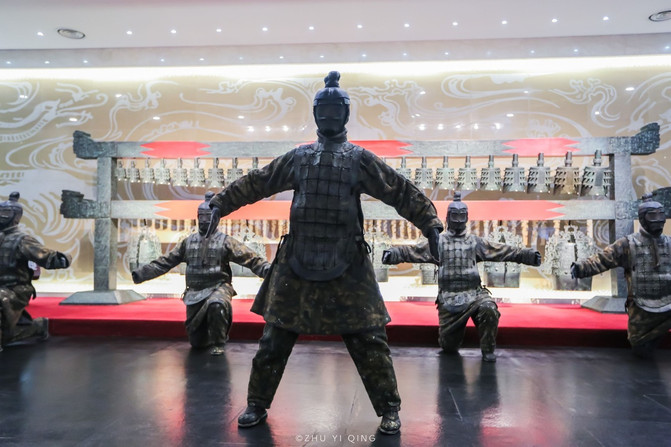

The ten-minute performance left me unfinished. If I have the opportunity, I will definitely watch it again.


Hancheng Lake, Emperor Wu of the Han Dynasty
Xi'an has produced several great emperors, among whom Liu Che, Emperor Wu of the Han Dynasty, was one. When it comes to Xi'an, everyone will think of Chang' an. The Tang Dynasty left a heavy mark on Xi'an, but everyone also forgot that another dynasty once established its capital in Xi'an. That was the Han Dynasty, just north of Xi'an. There are traces of the Han Dynasty, that is Hancheng Lake.

Hancheng Lake is located in Weiyang District, Xi'an City. Today, it is a large park with the theme of Han culture and a national-level water conservancy scenic spot. According to historical records, in the Han Dynasty, Hancheng Lake was an open channel for Chang 'an City's water transport. It was mainly responsible for the transportation of goods in Chang' an City, the capital city at that time. Strategically speaking, its location was extremely important.

The most iconic building in the scenic area is this sculpture of Emperor Wu of the Han Dynasty. The statue is about 21.5 meters high, implying that the Han Dynasty ruled China for 215 years. Its base is 7 meters high, which also means that Emperor Wu of the Han Dynasty and Liu Che were the seventh emperor of the Western Han Dynasty. This statue is also the largest among the portraits of Chinese emperors.

Another landmark building on Seoul Lake is Dafeng Pavilion, which is 64 meters high, has two floors underground and seven floors above ground. It is the commanding height of the Seoul Lake Scenic Area. Most tourists will choose to climb high and overlook the beautiful scenery of the scenic area and the ruins of Chang 'an City in the Han Dynasty. Dafeng Pavilion takes the meaning of the "Gale Song" by Liu Bang, the Gaozu of the Han Dynasty: The strong wind rises, the clouds fly, and the power of the sea returns to my hometown. How can I get the artistic conception of brave soldiers guarding the four directions?


You can also rent a set of Hanfu clothes in Seoul Lake. Only by walking between Seoul Lake can you feel more like traveling through it.

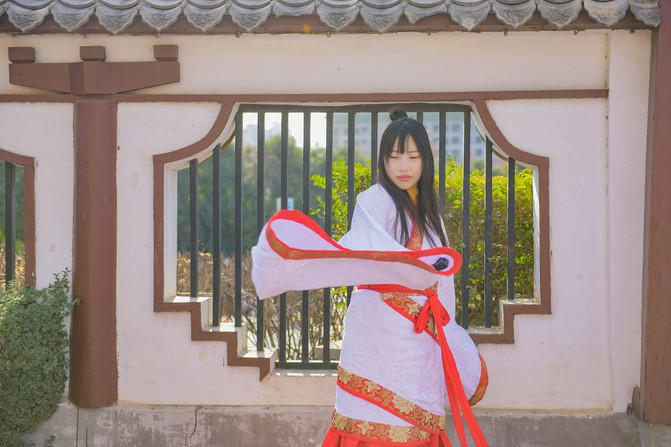
Or participate in a training session on Han Dynasty etiquette to learn how people bowed during the Han Dynasty.

Wearing Han costumes and feeling the majesty brought by the long years, maybe we are so far away from the Han Dynasty and not as close as the Tang Dynasty, but with the popularity of Han costumes and the pursuit of Han culture, the Han Dynasty, which "committed the Ming Dynasty to strengthen the Han Dynasty, must be punished even if it is far away", still has warmth in Xi'an.


Bell Tower is on the left, Drum Tower is on the right
There are so many landmarks in Xi'an that I can't tell you enough. The Drum Tower and Bell Tower located in the center of the city are on par. They are both the most popular landmarks in Xi'an.

There is a saying that if you have not been to Xi'an before the Bell Tower, you have not been to Xi'an, so the Bell Tower stands out among the many ancient buildings in Xi'an. The Bell Tower is located in the center of Xi'an City, at the intersection of four streets in the east, west, north and south. It has a history of more than 700 years and is the most completely preserved Bell Tower in China.

Xi'an Drum Tower is one of the largest and most completely preserved Drum Tower among the many Drum Tower left over from ancient China. Built on a square base, it is a brick-and-wood structure with a double eaves at the top. It has a total height of 36 meters and covers an area of 1377 square meters. There are stairs that can be spiraled up. It is also a landmark building in Xi'an.

The two Ming Dynasty buildings are both similar and different, echoing each other from afar and making them spectacular.

The drum of the Drum Tower has also won the Great World Gisney Record and is the largest drum in the world.

We all know that in ancient times, the bell was struck to announce morning and the drum was beat to announce dusk. The morning bell and dusk drum were once a portrayal of the real life of the people in this ancient city. Now only these rows of drums are left, as if you can still hear the drums of thousands of years ago.

The Bell Tower and the Drum Tower are the best commanding heights in Xi'an. Climbing either of these two high-rise buildings, you can overlook the lively streets of Xi'an where cars come and go. This is the most prosperous and lively place in Xi'an. Traffic flows here, and It scattered from here. Looking at the busy traffic, I also wondered from time to time, what kind of scene would it be like here if it were more than a thousand years ago?


In the Drum Tower, there was also a music-related performance, which was a Qin music performance. There were chimes, drums, erhu, flutes and other folk music instruments, allowing me to once again appreciate the charm of folk music as a student of Western music.


The melodious sound of the pipa and the crisp sound of chimes, these music that has been passed down for thousands of years, are still not outdated even if you listen to it now.


Yongxing Square, Xi'an Food Memory
When it comes to Xi'an's food streets, where does the first thing you think of? Is it Hui Street? This food street, which has long been crowded with people, is not the destination of my trip. This time, I chose the place to make Xi'an Internet celebrity city. Yongxing Square, which is the place where a bowl of wine is poured into Xi'an. Become an Internet celebrity city.

Shuowan wine was born here. Now, when you come to Shuowan wine in Yongxing Square, a large pile of broken wine bowls has been piled up here. Shuowan wine is also about etiquette. Facing the east, you lift the bowl. Above your head, you acquiesce in your wish, bow three times and take a sip, and then throw the wine bowl into the distance heavily, implying good luck in the coming year.

After talking about breaking bowls of wine, let us go back to Yongxingfang again. This was once the former site of Weizheng Mansion in the Tang Dynasty. In order to continue to improve the historical features of Shuncheng Lane, fully demonstrate the historical heritage of the ancient city, and expand Xi'an's popularity and influence, Xi'an City built this Yongxingfang on the original site. Now it is mainly composed of Guanzhong archways and buildings with folk traditions to display the neighborhood form and historical life atmosphere of ancient Chang 'an City, as well as the traditional folk living space.


There is no doubt that people who come to Yongxing Square do not come for food. Yongxing Square is a famous food street in Xi'an. There are more than a hundred shops, large and small, and a variety of Shaanxi snacks are gathered. It is really the rhythm of eating each house. Cold rice noodles, sesame cakes, potato glutinous rice cakes, white flint soup, Lantian buckwheat noodles and heli... are all kinds of snacks that I don't usually eat.

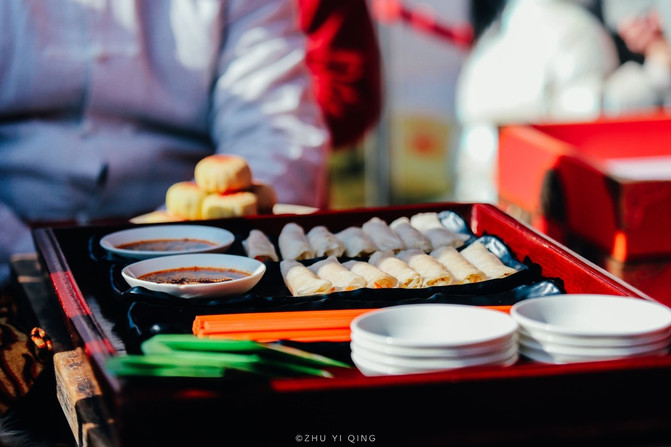

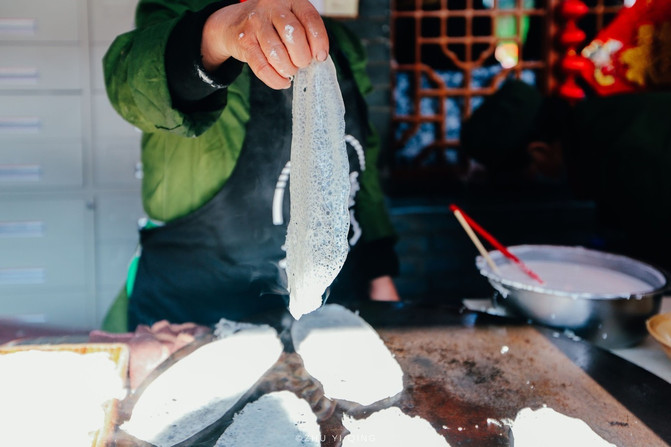
Zhashui potato glutinous rice cake is known as an intangible cultural heritage. The potatoes are pressed open with a wooden hammer and kneaded back and forth one or two times before it becomes sticky. The hammered cake is soft as if it has no bones. It is placed on a chopping board and used a knife to force everything., the whole lump, the whole piece, soft but not scattered, and it is very strong. When placed in a seasoning pot and hot, the aroma will drill straight into your nostrils, which is very tempting and opens your appetite.

Shaanxi noodles, look at the way they hang them, and they were once published in "China on the Bite of China". Shaanxi noodles not only have requirements for elasticity, but also have very particular demands on flour and fermentation time in terms of production methods. The time for hanging noodles is more than tens of minutes.

Shaanxi hemp flowers are also very famous. You must eat them when they are just made. They are very crispy.

I swallowed a mouthful of saliva while writing. Shaanxi's cold rice noodles are also a representative delicacy in Shaanxi. They are added with various dried bamboo shoots ingredients and a little spicy pepper. It is simply enjoyable to eat.
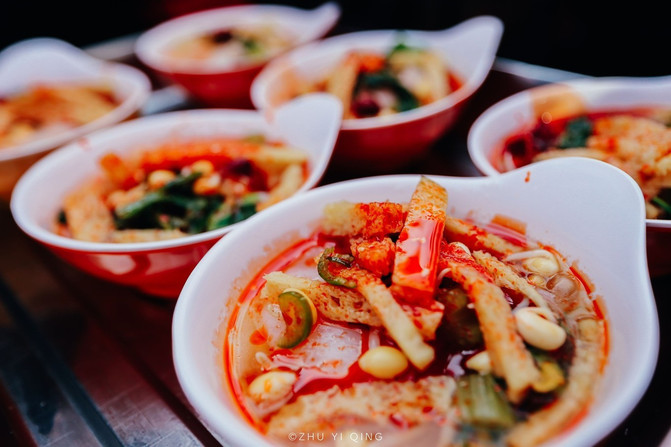

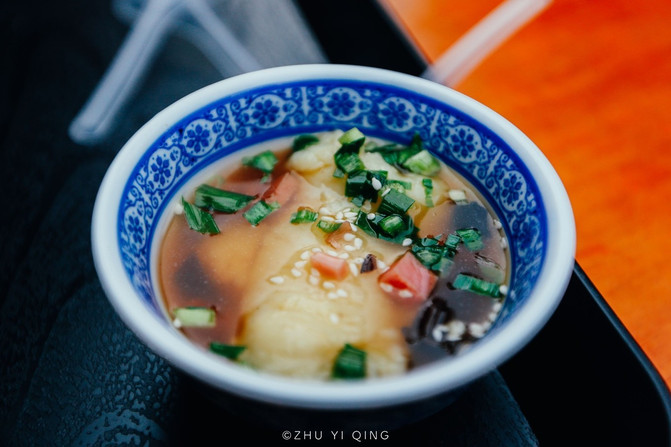
Probably because Shaanxi is geographically close to Sichuan and also likes to eat spicy food. Looking at the red spicy oil, you will have an appetite.



There are also many folk performances in Yongxing Square. For example, this puppet Indian dance performance combines Chinese culture with India's foreign culture. There are many audiences watching it below. Each person can hold a small teacup and watch the performance with gusto.


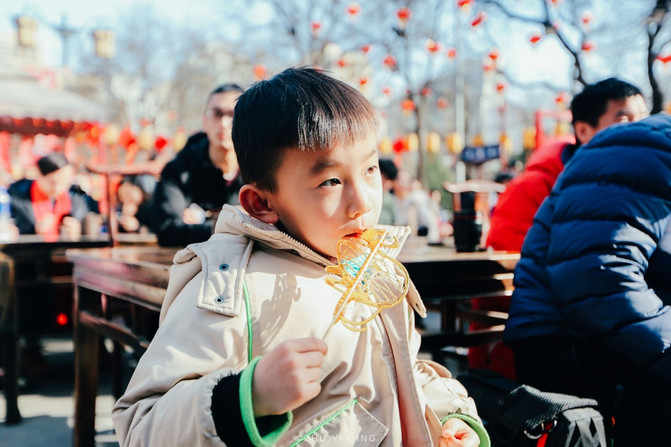
Guanzhong Tower, tasting Wei Zheng's family banquet
Since you are in Wei Zheng's territory, you must come and try Wei Zheng's family banquet. There is a restaurant in Yongxingfang that specializes in Wei Zheng's family banquet cuisine, called Guanzhong Tower.

The entire Weizheng Family Banquet contains 21 dishes in ten categories, including Qinzhen rice skin, Lantian, Roujiamo, raw sea bass, Datang cheese fish, noodles and spicy rice, a large bowl of Biang Biang noodles, etc.
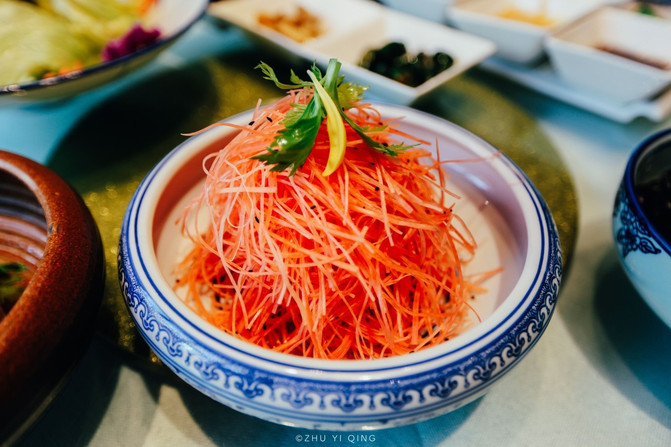

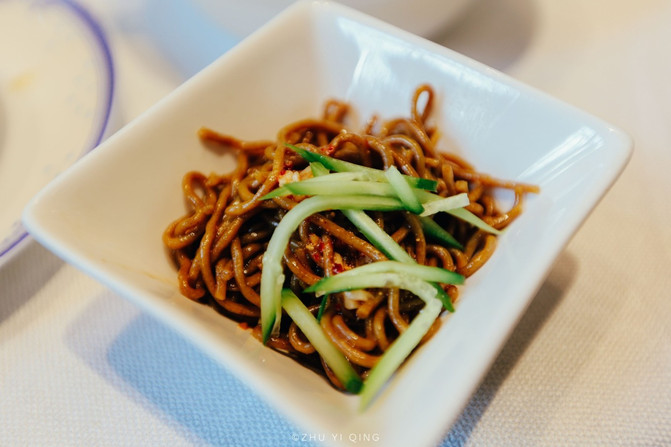



Daqin Small Banquet, Qin Dynasty Delicious Feast
If you want to taste authentic Sanqin cuisine and experience the different dietary customs of Qin Dynasty people, you must not miss the Daqin Small Banquet. Here you can experience how to eat like Qin people. As soon as he entered, he was attracted by the pictures of this restaurant, as if he had traveled through time.

There are also etiquette music such as chimes and guzheng, which you can tap and play.


After the formal banquet, the waiter served everyone one by one. After each serving, he would tell the story behind the dish, which was also improved based on the dishes eaten by the Qin people.



Every dish will not be very big, but it is mainly for tasting. It is very similar to Japanese cuisine, so the dishes are very exquisite, and even the utensils are very elegant.
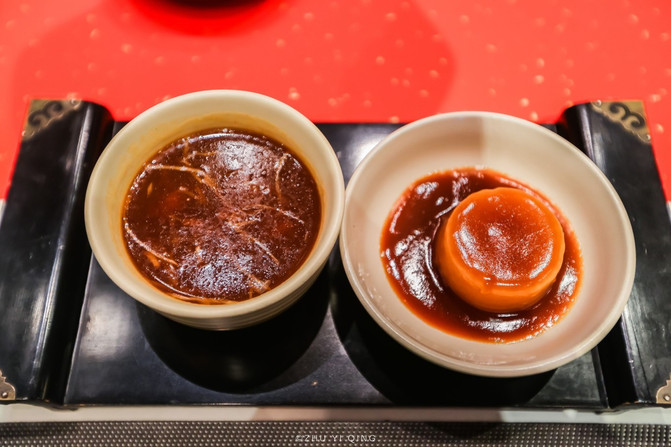



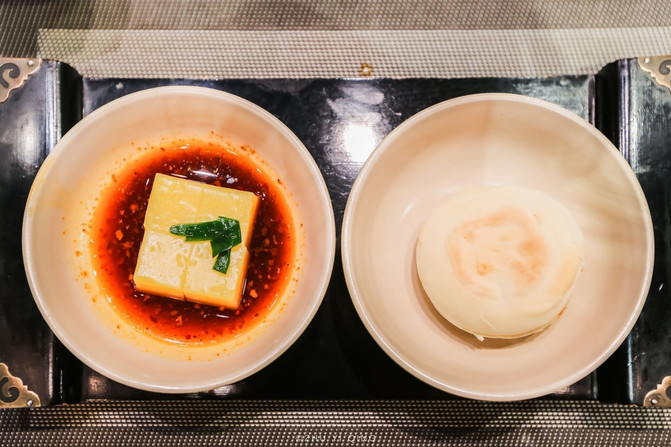

Drunken Chang 'an, the most authentic Shaanxi food
When it comes to a popular restaurant in Xi'an, it must be Drunken Chang' an. If you want to eat here, you don't book a table in advance. You have to queue up for an hour at the scene. This place can be said to be the most authentic and popular Shaanxi cuisine.

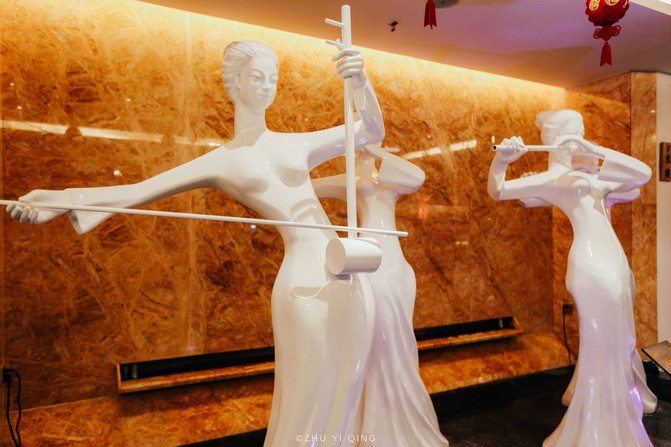
What impressed me deeply was this tripe, called dry-clothes tripe. It is very interesting to set up the plate. The tripe is also very crisp and very refreshing.

Other signature dishes include Lao Shaanxi gourd chicken, Miao Bi Sheng Hua, squirrel fish, warm pot, etc., which are all popular dishes here. There is also one of the top ten famous dishes in Shaanxi, which is very delicious.




If I were to rank the delicious food in Xi'an in the past few days, Drunken Chang' an would definitely be the number one in my mind. If I come to Xi'an again, I would choose to come to Drunken Chang' an to get drunk.
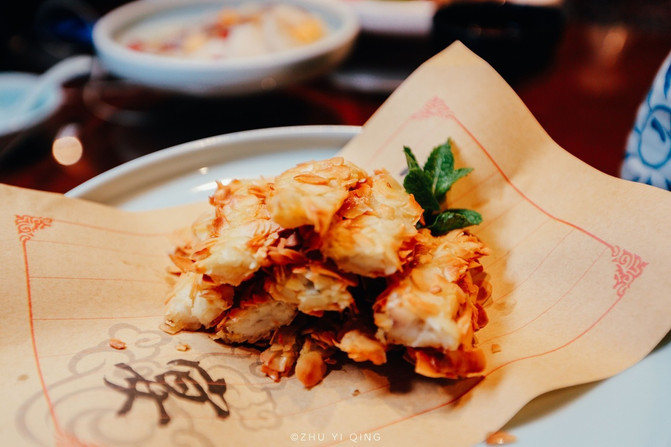



Dream back to the Tang Dynasty and remember Chang 'an again
After talking about playing and eating, there are still many performances to watch in Xi'an. When I get off the airport and turn to the light rail, I can see the billboard of Dream Back to the Datang University, which makes me very curious about this performance. In the Datang Furong Garden, I also had the honor to watch the entire performance.
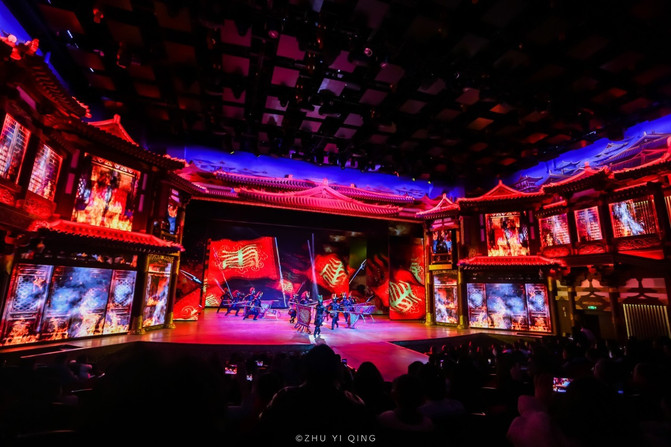
Dream Hui Tang performed at the Fengming Jiutian Theater in the Furong Garden of Tang Dynasty. The entire play lasted 70 minutes and was divided into six acts. They are the preface: "Dream in the Garden", the first act: "Dream of Nishang", the second act: "Dream of Inviting the King of Qin", the third act: "Dream of Bathing in Huaqing", the fourth act: "Dream of the Western Regions", the fifth act: "Dream of Wandering in Qujiang", the sixth act: "Dream of Returning to the Tang Dynasty."


It has both gorgeous costumes and superb acrobatic skills, which makes people dizzying.


Following the performances of the actors, I felt like I had traveled back to the Tang Dynasty and felt all of this with them.


With the exquisite costumes and the climactic storyline, I also entered the story without realizing it.


It turned out that there was also the help of Persian beauties, which instantly gave the performance an international character.

In the theater, it was like having a dream that traveled through thousands of years, and all of a sudden, I dreamed back to the Tang Dynasty.


The End
Compared with Xi'an, where I came to seven years ago, it can be said that great changes have taken place here, or it can be said that it has not changed much in the long river of time.
Xi'an, an ancient capital with too much history and one of the most New Year's flavor cities in China, has attracted many people.
Everyone should come to Xi'an to experience the New Year.
Chinese New Year, in Xi'an, I spent the New Year in Xi'an.
Previous Article:Chang 'an Chapter on Dora's Wonderful Journey
Next Article:Seven-day Parent-Child Tour in Xi'an (2019.8.17-23)
